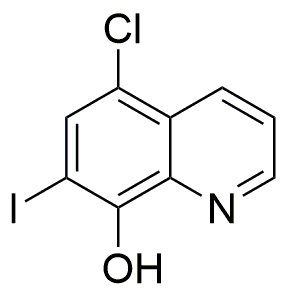5-Chloro-8-hydroxy-7-iodoquinoline is widely utilized in research focused on:
- Antimicrobial Research: This compound exhibits significant antibacterial properties, making it valuable in the development of new antibiotics. Researchers explore its effectiveness against resistant strains of bacteria.
- Antiparasitic Applications: It has shown promise in treating parasitic infections, particularly those caused by protozoa. This is crucial in fields like tropical medicine and veterinary science.
- Fluorescent Probes: The compound is used in the creation of fluorescent probes for biological imaging, allowing scientists to visualize cellular processes in real-time, which is essential in cellular biology and pharmacology.
- Drug Development: Its unique chemical structure aids in the design of novel therapeutic agents. Pharmaceutical companies leverage its properties to create more effective drugs with fewer side effects.
- Environmental Monitoring: The compound is also being researched for its potential use in detecting pollutants in water sources, contributing to environmental safety and public health initiatives.
General Information
Properties
Safety and Regulations
Applications
5-Chloro-8-hydroxy-7-iodoquinoline is widely utilized in research focused on:
- Antimicrobial Research: This compound exhibits significant antibacterial properties, making it valuable in the development of new antibiotics. Researchers explore its effectiveness against resistant strains of bacteria.
- Antiparasitic Applications: It has shown promise in treating parasitic infections, particularly those caused by protozoa. This is crucial in fields like tropical medicine and veterinary science.
- Fluorescent Probes: The compound is used in the creation of fluorescent probes for biological imaging, allowing scientists to visualize cellular processes in real-time, which is essential in cellular biology and pharmacology.
- Drug Development: Its unique chemical structure aids in the design of novel therapeutic agents. Pharmaceutical companies leverage its properties to create more effective drugs with fewer side effects.
- Environmental Monitoring: The compound is also being researched for its potential use in detecting pollutants in water sources, contributing to environmental safety and public health initiatives.
Documents
Safety Data Sheets (SDS)
The SDS provides comprehensive safety information on handling, storage, and disposal of the product.
Product Specification (PS)
The PS provides a comprehensive breakdown of the product’s properties, including chemical composition, physical state, purity, and storage requirements. It also details acceptable quality ranges and the product's intended applications.
Certificates of Analysis (COA)
Search for Certificates of Analysis (COA) by entering the products Lot Number. Lot and Batch Numbers can be found on a product’s label following the words ‘Lot’ or ‘Batch’.
Numéro de catalogue
Numéro de lot/série
Certificates Of Origin (COO)
This COO confirms the country where the product was manufactured, and also details the materials and components used in it and whether it is derived from natural, synthetic, or other specific sources. This certificate may be required for customs, trade, and regulatory compliance.
Numéro de catalogue
Numéro de lot/série
Safety Data Sheets (SDS)
The SDS provides comprehensive safety information on handling, storage, and disposal of the product.
DownloadProduct Specification (PS)
The PS provides a comprehensive breakdown of the product’s properties, including chemical composition, physical state, purity, and storage requirements. It also details acceptable quality ranges and the product's intended applications.
DownloadCertificates of Analysis (COA)
Search for Certificates of Analysis (COA) by entering the products Lot Number. Lot and Batch Numbers can be found on a product’s label following the words ‘Lot’ or ‘Batch’.
Numéro de catalogue
Numéro de lot/série
Certificates Of Origin (COO)
This COO confirms the country where the product was manufactured, and also details the materials and components used in it and whether it is derived from natural, synthetic, or other specific sources. This certificate may be required for customs, trade, and regulatory compliance.


